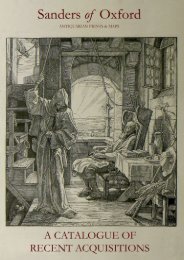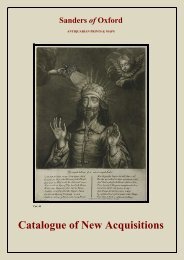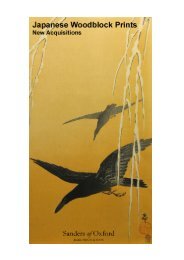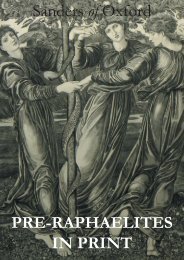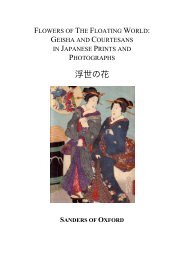Mezzotints & Engravings after J.M.W.Turner.pdf - Sanders of Oxford
Mezzotints & Engravings after J.M.W.Turner.pdf - Sanders of Oxford
Mezzotints & Engravings after J.M.W.Turner.pdf - Sanders of Oxford
Create successful ePaper yourself
Turn your PDF publications into a flip-book with our unique Google optimized e-Paper software.
Image 256 x 365 mm, Plate 281 x 389 mm, Sheet<br />
309 x 408 mm<br />
unmounted<br />
Engraver’s pro<strong>of</strong> before all letters. Impression on<br />
laid paper.<br />
Signed to lower right side <strong>of</strong> plate mark by ‘Frank<br />
Short’. Inscription reads: ‘To Mrs. John Edward<br />
Taylor’<br />
Surrounded by large rocks, and at the foot <strong>of</strong> steep<br />
banks, the focus <strong>of</strong> this image is on a pool. Behind<br />
the boulders and the shallows, a cave occupies the<br />
central plane <strong>of</strong> the composition. In the secluded<br />
dell <strong>of</strong> <strong>Turner</strong>’s view, the artist does not employ<br />
human staffage. Instead, a heron emerges from the<br />
hollow between the banks and flies towards the<br />
water. In conformity with the original watercolour,<br />
Short’s mezzotint is indiscriminate and<br />
impressionistic. He contorts the technique <strong>of</strong> the<br />
medium in order to produce a hazy impression<br />
suited to the representation <strong>of</strong> <strong>Turner</strong>’s briars and<br />
lagoons.<br />
Sir Frank Short (1857-1945) was an English<br />
printmaker from Stourbridge, Worcestershire. He<br />
was instrumental in the revival <strong>of</strong> mezzotint and<br />
aquatint practise and was elected as the head for the<br />
department <strong>of</strong> engraving at the Royal College <strong>of</strong><br />
Art in 1933. An ardent student <strong>of</strong> the works <strong>of</strong><br />
J.M.W <strong>Turner</strong>; Short’s reproductions <strong>of</strong> the Liber<br />
Studiorum delineate his exacting skill as well as a<br />
sympathetic study <strong>of</strong> the originals. Upon<br />
completion <strong>of</strong> <strong>Turner</strong>’s most famous series, Short<br />
turned to his more esoteric material and published<br />
subjects <strong>of</strong> which the artist and his assitants had left<br />
incomplete years before. Several fine plates resulted<br />
from this study. In addition to his plaudits as a<br />
Royal Academician, Short twice won the gold<br />
medal for engraving at the Paris International<br />
Exhibition and was later knighted.<br />
[27611]<br />
£200<br />
27. Kingston Bank<br />
Mezzotint<br />
Frank Short <strong>after</strong> J.M.W <strong>Turner</strong><br />
1896<br />
Image 263 x 198 mm, Plate 275 x 211mm, Sheet<br />
434 x 307 mm<br />
unmounted<br />
First published state.<br />
Signed to lower right side <strong>of</strong> plate mark by ‘Frank<br />
Short.’<br />
<strong>Turner</strong>’s view <strong>of</strong> Kingston Bank formed an<br />
unpublished part <strong>of</strong> <strong>of</strong> the Liber Studiorium, or the<br />
Book <strong>of</strong> Studies. A personal manifesto, the series<br />
constituted <strong>Turner</strong>’s ambitions for landscape art.<br />
Intended to be widely disseminated, the prints were<br />
begun in 1807 and were published in fourteen<br />
groups <strong>of</strong> five. By 1819 however, the project was<br />
faltering, unable to live up to the grand expectations<br />
<strong>Turner</strong> had envisaged. Though the artist fell short,<br />
the project was later resurrected by Frank Short and<br />
previously arcane views began to surface.<br />
<strong>Turner</strong>’s relatively sparse composition depicts a<br />
broad reach <strong>of</strong> river at harvest-time. Men process<br />
the crop on top <strong>of</strong> a cart whilst the shape <strong>of</strong> horses<br />
appear over the cornfields on the left. A man stoops<br />
to wash his face in the water, perhaps to convey the<br />
stifling heat <strong>of</strong> a summers morning. The clouds feel<br />
muggy and oppressive whilst light falls in linear<br />
beams upon the drowsy workers. A barge floats on<br />
the right, a horse-drawn cart ambles beyond it, and<br />
buildings appear on the horizon.<br />
Condition: Time-toned paper. Large area <strong>of</strong> foxing<br />
to left hand side <strong>of</strong> sheet, one spot <strong>of</strong> which affects<br />
the image just above the cornfields.<br />
[27642]<br />
£175




